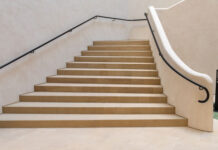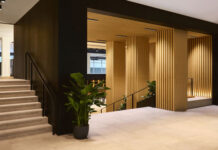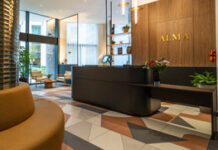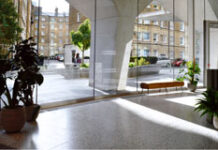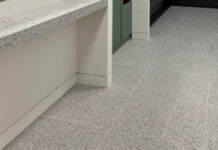 William Butler Simpson was born in 1798, and inherited his talent as an artist from his father, and founded the firm in 1833. He gradually built up the business during his lifetime before passing away in 1882 at the age of 84.
William Butler Simpson was born in 1798, and inherited his talent as an artist from his father, and founded the firm in 1833. He gradually built up the business during his lifetime before passing away in 1882 at the age of 84.
In 1849 The Society of Arts presented him with a gold medal in recognition of his efforts to promote the improvement of design, particularly in wallpapers. In 1851 he received a bronze medal from at the International Exhibition of Decorators, and was further made a Freeman of The City of London.
In 1852 his two sons, William Fredrick, and Edward Henry, were apprenticed to the firm and later were made partners in 1860. It was they who altered the style of the firm to W.B.Simpson & Sons. They traded from 456 West Strand, opposite the Grand Hotel, but in 1868 moved to premises built by the sons at 100 St Martins Lane. The whole of the upper floors of 100 St Martins Lane was used as tile painting studio and for Mosaic and Ecclesiastical “Opus Sectile” panels and stained glass. Single 8”x8” hand painted tiles then sold from 2/- up to 30/-.
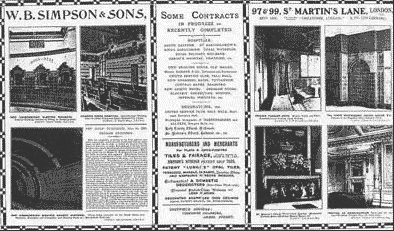 In 1858 an arrangement was made with George and Arthur Maw of tile manufacturers Maw & Co for the sole agency of their products in the London Postal District. This arrangement grew, as from 1862 many new features in the tiles were manufactured such as printed patterns, decorative faience on architectural lines, and coloured enamel tiles for particular use on fireplaces. A pair of fireplace panels would sell for up to 30 guineas a pair!
In 1858 an arrangement was made with George and Arthur Maw of tile manufacturers Maw & Co for the sole agency of their products in the London Postal District. This arrangement grew, as from 1862 many new features in the tiles were manufactured such as printed patterns, decorative faience on architectural lines, and coloured enamel tiles for particular use on fireplaces. A pair of fireplace panels would sell for up to 30 guineas a pair!
Simpsons also made their own tiles, usually on “bisque” supplied by Maw & Co to their kilns under the South Western Railway arches at Vauxhall, and later at Chandos Street, which later became The Civil Service Stores. A large business was also done in hand painted tile decorations for theatres, restaurants, turkish baths, and Cathedrals, many of which still exist today such as the Criterion Theatre, Holborn Restaurant, and St Asaph Cathedral.
Eventually Fredrick retired in 1892, and Edward in 1894, handing over to Edward Graham and Fredrick Coleridge Simpson. They set about reorganising the company to meet the demands of large scale plain tiling required for the many new operating theatres, toilets and clinics throughout the country. They also had to meet the challenge of the largest contract ever undertaken by a single tile company at the time, the London Underground.
This contract comprised station work to the Hampstead & Highgate Railway, the Piccadilly & Brompton Railway and the Bakerloo Line. Within the price of £100,000 was included the necessary cranage to lower the materials and our own trains for moving about underground! The storey of the underground is a whole subject in itself, and further details and records are available. In fact to this day, the company is actively involved in the creation of new stations on projects such as the Jubilee Line Extension, to the maintenance and updating of many existing stations throughout the network.
 Following the difficult years of the First World War, Mr G.Colin Simpson and Lionel Simpson were made Directors of the firm in 1925. The firm was then formed into a Private Limited Company, W.B.Simpson & Sons Limited, with a fully paid share capital of £5000. These gentlemen took full control in 1929 when their fathers retired and again set about updating the business.
Following the difficult years of the First World War, Mr G.Colin Simpson and Lionel Simpson were made Directors of the firm in 1925. The firm was then formed into a Private Limited Company, W.B.Simpson & Sons Limited, with a fully paid share capital of £5000. These gentlemen took full control in 1929 when their fathers retired and again set about updating the business.
By 1936, further premises were required and a lease was taken out on a yard at 6 Whitcher Place Camden Town NW1. The increase in business also saw the issue of 20,000 Preference Redeemable Shares in 1937 that were enthusiastically taken up by professional advisors, friends, family and the Directors themselves.
The outbreak of the Second World War saw a virtual standstill in the company’s main activities, but soon after 1945, new premises were acquired for £7000 at 374 Wandsworth Road SW8, subsequently named St Martins House after the office in St Martins Lane, a tradition carried through the company today.
This property was a large 3 storey detached house and factory where precast terrazzo, mosaic and tiled panels were produced. Tile fixers returning from the war were also engaged in painting and decorating war damage work, and making terrazzo fireplaces for the “prefabs” being built for blitz victims.
More democratic times were ahead. In 1939 employees of the firm, John A Clark and George Fernie, were appointed Directors. G.Colin Simpson resigned from the company in 1946 and Lionel continued to run the business through the unprecedented expansion of the company following the war. During this period the Company was engaged in commercial, industrial, and Local Authority work all over the UK, including work at London Docks, and the many new hospitals and public buildings constructed in this period.
In 1950 Fred Bird was appointed a Director, and Joint Managing Director in 1960. Fred continued until 1981, a total of 51 years with the company, having risen from office boy at St Martins Lane.
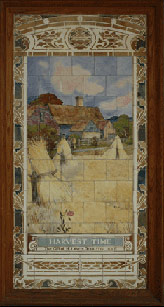 In 1962 with the past wealth of the company dissipated throughout the Simpson family and the Banks unwilling to help, the premises at Wandsworth Road were sold to provide capital for expansion. The company moved to rented offices at 159-163 Clapham High Street SW4 as well as purchasing a yard at Burr Road Wandsworth. A third share in a pre-cast company followed to maintain the supply of terrazzo products, and also added the supply and fixing of marble products to it traditional business.
In 1962 with the past wealth of the company dissipated throughout the Simpson family and the Banks unwilling to help, the premises at Wandsworth Road were sold to provide capital for expansion. The company moved to rented offices at 159-163 Clapham High Street SW4 as well as purchasing a yard at Burr Road Wandsworth. A third share in a pre-cast company followed to maintain the supply of terrazzo products, and also added the supply and fixing of marble products to it traditional business.
The next decade was marked by the growth of the use of tiles and mosaics as external cladding to concrete structures such as St Thomas’s Hospital that has 26,000 sm of tiling over 16 storeys. Exhibited inside the building are also the original hand painted children’s ward Victorian nursery rhyme tiled panels.
By 1968, long-term employee’s Stan Valler and Jim (Giovanni) Tiramini were both appointed to the management of the company bringing practical experience with them. Following this in 1971, Lionel Simpson retired ending the continuous management of the company by four generations of the Simpson family. Loyalty and long service were still maintained as a tradition of the company however and Brian James joined the board in 1979, and at this time with a 20-year record with the company.
The following year Stan Valler was made Joint Managing Director in preparation for Fred Bird’s planned retirement in 1981, and in 1982, Chris Noyes, another long serving employee, was also appointed to the Board.
In December 1975 the lease on 159/163 Clapham High Street had expired and the company moved once again to 16 Bromells Road where storage facilities were available, however by 1979, having secured strong financial independence, a new purpose built headquarters was commissioned for the site at Burr Road Wandsworth, and the company moved in on its completion in December 1987. Another St Martins House was born.
The company was yet again on the threshold of a new expansion with the London and South East booming with shopping malls, airport buildings, supermarkets and other prestige projects. Along with these projects, the company now began to invest in other businesses.
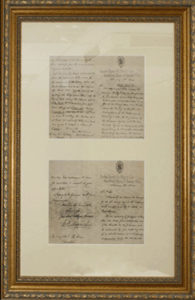 Trafalgar Properties Ltd had been set up and owned by Simpson’s since 1924, trading under the name of The General Building Company. During the 1930’s it had built some fine buildings such as Pinners Hall and Abbey Lodge in Regents Park for the Simpson family. The company continued to trade after the war, but only as maintenance and decorating firm. This was due to the need to concentrate the available resources on the survival of Simpsons.
Trafalgar Properties Ltd had been set up and owned by Simpson’s since 1924, trading under the name of The General Building Company. During the 1930’s it had built some fine buildings such as Pinners Hall and Abbey Lodge in Regents Park for the Simpson family. The company continued to trade after the war, but only as maintenance and decorating firm. This was due to the need to concentrate the available resources on the survival of Simpsons.
In 1985 The General Building Company was incorporated as a separate company. Trafalgar Properties became a holding company for the newly formed group that now contained Maxon Tiling, Pallam Precast, Kengate Products, The Bath House, Banstead Builders Merchants, as well as W.B.Simpson & Sons. The original Preference Shares issued in 1937 were also redeemed bringing the control of the company firmly into the hands of the working directors.
During the same year, the largest contract to date was awarded at the North Terminal Gatwick Airport for the new terrazzo flooring to a value in excess of £2M. Completed on time and to budget, this was a contract that even William Butler himself would have been proud of.
Construction had also now begun on the new premises at Burr Road Wandsworth. In December 1987 a “new” St Martins House complete with terrazzo staircases, marble walls, and the finest ceramics to gave the company a home in keeping with its history and traditions. The success of this new building was however short lived. The early 1990’s saw a construction industry in crisis and the WBS group were caught up in one of the longest and deepest recessions for many years. Rationalisation was called for and it became obvious that the volume of available good quality work and turnover could not be maintained, so plans were laid to consolidate the business.
Chris Noyes, who had been recently appointed as a Director, decided to join a friend in another business venture in 1994, the building at Burr Road was sold, and the group activities consolidated on the new site at Banstead. As with many established London Business’s our journey from St Martins Lane to the outskirts of London continued. The new technology in mobile phones, faxes, and computers meant that we no longer had to be in the metropolis to continue our business.
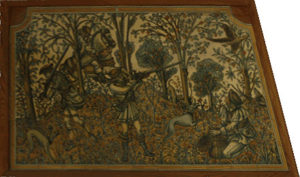 Another new building was also commissioned for the site at Banstead suitable for W.B Simpson and Banstead Builders Merchants. The company moved into Banstead during 1999, following on from temporary offices at Carshalton using modern office space and a dedicated warehouse and yard for storage.
Another new building was also commissioned for the site at Banstead suitable for W.B Simpson and Banstead Builders Merchants. The company moved into Banstead during 1999, following on from temporary offices at Carshalton using modern office space and a dedicated warehouse and yard for storage.
Paul Valler, who joined the Company at the age of 16 as a tiling apprentice, became a Director in 1995. He previously had a spell as manager of The General Building Company, supervising amongst others the construction of the building at Burr Road and the new HQ at Banstead. The GBC was now closed down and Paul took control of the Tiling section of the company with Brian James heading the terrazzo factory and contracting division.
Meanwhile Stan Valler, after 42 years service with the company, resigned as Managing Director in 1998. Stan continued his association with W.B.Simpson as a consultant, and 2006 saw him complete 50 years of service to the company, a fact noted and enthusiastically celebrated by the past and present members of the firm!
Despite the economics of the period, the firm was still entrusted with many prestigious contracts such as the New British Library, Castle Mall Norwich, Terminal 2 Heathrow, South Terminal Gatwick, Brent Cross Centre, Liffey Valley Centre in Dublin and Canary Wharf in London to name but a few.
Additionally, after 100 years of originally working on the London Underground, we were called on to provide our services on the new Jubilee Line Extension. New stations at Canada Water, Southwark, and North Greenwich, as well as existing stations on the line at Waterloo and Westminster all were added to our impressive portfolio.
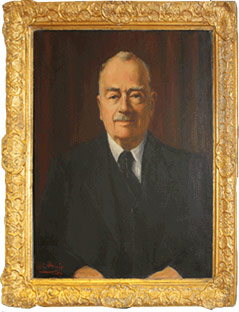 As well as the Jubilee Line Extension, the next 5 years saw a steady increase in large projects, and W.B.Simpson completed work at Chelsea FC West Stand, Croydon Centrale, Fulham Broadway, Grants of Croydon, Canary Wharf, and a large number of prestigious office and leisure developments throughout London and the South East.
As well as the Jubilee Line Extension, the next 5 years saw a steady increase in large projects, and W.B.Simpson completed work at Chelsea FC West Stand, Croydon Centrale, Fulham Broadway, Grants of Croydon, Canary Wharf, and a large number of prestigious office and leisure developments throughout London and the South East.
Alongside these projects is the long-term up-date of the London Underground system, and once again the company is involved in up to 10 stations at a time on this 15-year, deja-vue project. In order to tackle this work, Matt Pearson was invited into the company as a Director to oversee this work from his general building background.
Further capacity was also created by the formation of a new branch of the company in 2004 based in Coventry to effectively serve the midland and northern areas of the country. This saw Richard Friebe join the company along with Anthony Parrott to oversee the project and further spread the reputation of W.B.Simpson & Sons.
Following the expansion of the company over the previous 5 years, a new move was made by the company from Banstead to Redhill during December 2008. The company purchased and refurbished 2 warehouse units totalling 700 square metres of warehouse and office space capable of supporting the company infrastructure. A new St Martins House was born!!
Despite the expansion and the new office and warehouse building the Company can only exist if enough work is available to carry out and following the banking crisis in 2008 the workload of the group fell in line with the general recession throughout the construction industry and the country in general. Following a further re-organisation to deal with the reduced volume of work and turnover W.B.Simpson sought out and completed the tiling work to the new Zaha Hadid designed Olympic Aquatic Centre at Stratford comprising 2 new 50 metre swimming pools and a 6 metre deep diving pool and also worked on part of the Athletes Village for BAM in preparation for the 2012 Olympic Games.

